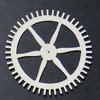Projects I Contribute To
Things I've Built
ZX80 with 40-column text
I wanted square pixels, which meant raising the clock speed from 6.5 to 7.375 MHz. Which added enough room for 40-column text. So I did it.
Integrated Amplifier front panel
Runs the user interface for a power amplifier and essentially an analogue multiplexer with volume control chips. It can skip over the internal application code and become the front panel for other products!
STEbus boards
Current hobby project is getting various processor boards running on the STEbus. Mostly from a company I worked for 1986-1990, but I'm also designing a 65C02 design running BBC BASIC at 8MHz, and a Z180 board.
80C32 board
Interfaces CANbus to a valve controller block. The customer expected a tiny bit of test code, but I had cheekily designed it to support BASIC. :-)
80C188 board
Interfaces servo controller commands (on RS485) with a fieldbus protocol card. It worked great!
Acorn Atom in FPGA
I taught myself VHDL with the Xilinx Web pack in 2001. Started off blinking an LED, and ended up here. See http://www.acornatom.nl/sites/fpga/acorn_atom_project.htm
Projects I Like & Follow
Share this profile
ShareBits
Become a Hackaday.io Member
Create an account to leave a comment. Already have an account? Log In.
Thanks for Liking my project #Reverse Engineering an old VMEBus CPU Board. It has been a fun project.
A friend of mine ported Elite onto the Raspberry Pi - in just two weeks!
Mind you, he did develop the R-Pi operating system. A very clever guy!
Thanks for liking/following my #Magnetic Bubble Memory Makes a Comeback project. I think it would be easy enough to make a patch board or make a Z80 CPU card for the SBC-85 system so it could use bubble memory too. Why let the 8085 have all the fun?
I thought of interfacing it to the STEbus, then any of my CPU boards can talk to it. However I wonder if there are many bubble memory components left in the world to make it worth while. I saw one module on eBay for £132. Too pricey for me to play with...
Thanks for liking Hippo-B-Gone! btw all your projects are very cool!!
 Keith
Keith sky-guided
sky-guided VALENTINE
VALENTINE DosFox
DosFox Dominic Emond-Belanger
Dominic Emond-Belanger tomcircuit
tomcircuit Tom
Tom jimshortz
jimshortz Stephen Willcock
Stephen Willcock Bharbour
Bharbour land-boards.com
land-boards.com sjm4306
sjm4306






Thank you. Cheers! Valentine